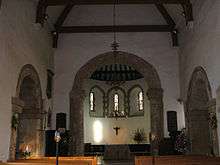St Nicholas' Church, Worth
St Nicholas Church is a Church of England parish church in Worth, a village in Crawley, England which at one time, had the largest geographical parish in England.
History
.jpg)
St Nicholas’ Church, Worth, is the 4th oldest church in the country and has been a place of Christian worship and devotion for well over 1000 years. It is known that the church is of Anglo-Saxon origin, and parts of it have been dated to between AD 950 and 1050, in particular the chancel arch and apse. It was built in what, at the time, was a forest. The reason for building a church here is unknown, but it is surmised that the area would have had good hunting grounds and royal or noble visitors to the grounds would need a place to pray in comfort. As it was a large church isolated in the forest, it is unlikely it was just for local needs. After the Norman conquest of England in 1066, William the Conqueror gave the church to his son-in-law William de Warenne, whose coat of arms is still visible in the stained glass windows of the church. In the 14th century, the church was passed from the de Warrenne family to the Fitzalan family, who lost it in 1415 to Nevills, Earl of Abergavenny.
Bell-ringing
Records of bell-ringing here go back to 1684, and bell-ringing still remains part of the weekly routine. The current tower, with its broached and shingled spire, was added in 1871 by Anthony Salvin.[1] to replace an earlier building which rested on tree trunks! A note from 1684 reveals that the church had 3 bells but an additional one was then added. The bells were re-cast in 1844 to form a peal of 6 and then again, by Gillett and Johnston of Croydon, in 1928. Since 1928, only routine maintenance was needed until 1997, when major work on the bells was carried out. Pulleys, wheels and clappers were removed and taken to the foundry for refurbishment, they were then refitted and the bells rehung. The bells are still hung in the oak frame dating from the 1844 installation, which sits on the belfry floor 1.5m (5ft)above the ringers’ heads but this was strengthened in 1997. The largest bell, the tenor, is 91cm (3ft) in diameter and weighs 489kg (9cwt 2qrts and 14lbs). Its note is A, the whole ring being harmonically tuned in the key of A. The total weight of bells in the tower is over 36cwt.
Restoration
In 1986 workmen were treating roof timbers of the church for protection against vermin when a fire broke out. The fire brigade quickly put out the blaze, saving the main building, but the roof timbers were severely damaged. This rendered the building unstable, however, which resulted in much scaffolding being put up, which in turn required pews and flooring to be removed. The roof was redesigned and the walls were strengthened. New floors and pews were fitted. The new pews, unlike the pre-restoration ones, are easier to move, giving the church more flexibility. The old pews were considered impossible to re-install in the church. The restoration cost about £510,000 and was complete by 1988. It was during the extensive renovation work that archaeologists were able to confirm the dating of the church’s original construction.
The church today

Worth Church is still in use as a parish church today, with at least two services each Sunday (usually 8am and 9.45am) and a midweek Eucharist on Wednesdays. Weddings, baptisms and funerals are all popular in this attractive venue. About 150 people are officially on the parish's electoral roll, and up to 400 people attend major services at Christmas and Easter. In evidence at many services are the bell-ringers and a small but good choir led by a professional Director of Music and Organist. There are youth groups, Messy Church and a special informal kids service "Nic's" twice a month at 11.15 on a Sunday. The official church website is http://www.worthparish.org
The churchyard includes the grave of Robert Whitehead, inventor of the modern torpedo. In a plot bordered with blue railings, his epitaph reads "His fame was known by all nations hereabouts".
See also
- Grade I listed buildings in West Sussex
- List of places of worship in Crawley
- Listed buildings in Crawley
- List of church restorations and alterations by Anthony Salvin
References
- ↑ Historic England. "The Parish Church of St Nicholas, Worth (1187114)". National Heritage List for England. Retrieved 1 October 2012.
Sources and further reading
- Nairn, Ian; Pevsner, Nikolaus (1965). Sussex. The Buildings of England. Harmondsworth: Penguin Books. pp. 641–642. ISBN 0-14-071028-0.
- Salzman, L. F., ed. (1940). A History of the County of Sussex, Volume 7: The rape of Lewes. Victoria County History. pp. 192–200.
- Wakelin, Roy (1988). Worth Church, Sussex. Crawley: Worth Publishing. pp. not cited. ISBN 0-9513451-0-9.
Coordinates: 51°06′37″N 0°08′30″W / 51.1103°N 0.1416°W
| ||||||||||||||||||||||||||||||||||||||||||